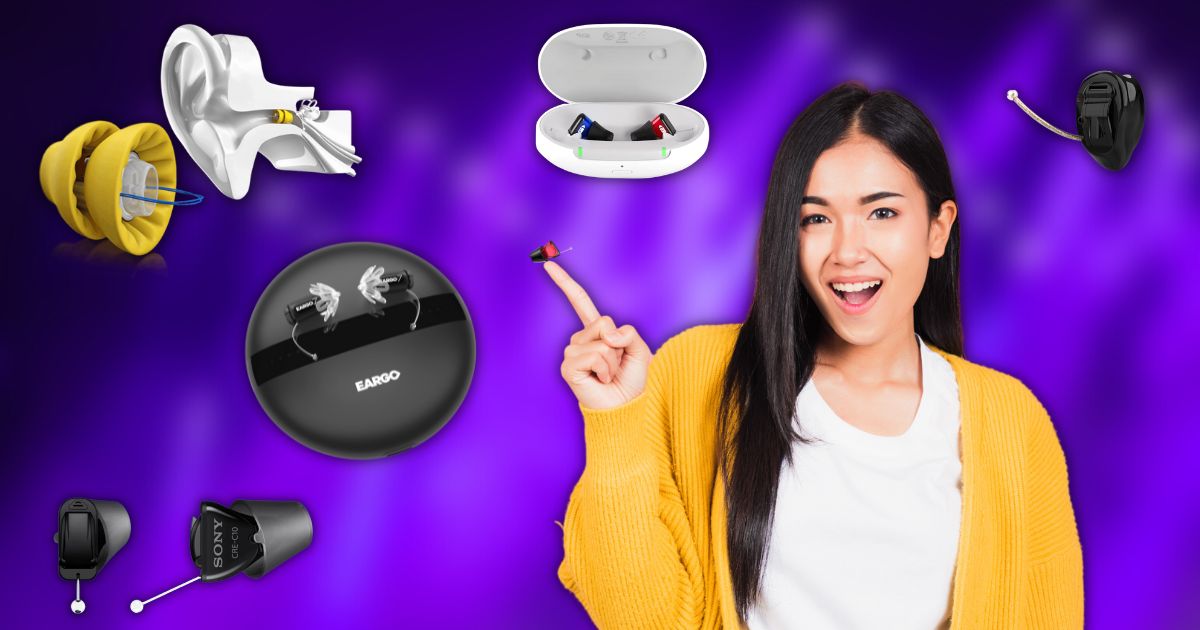The relentless pace of technological evolution has transformed every aspect of our lives, and hearing aids are no exception. In sync with contemporary needs, these devices have not only advanced technologically but have also evolved cosmetically.
As discreet technology gains acceptance, hearing aids have taken on the challenge of achieving near invisibility, becoming akin to personal secrets.
Hearing Device Stigma is Lessening…
 In the present landscape, AirPods and other earbuds have transcended their role as mere audio accessories to become a fashion statement, especially among the youth. Hearing aids are following suit, with some adopting the trendy earbud design, while others strive for true invisibility.
In the present landscape, AirPods and other earbuds have transcended their role as mere audio accessories to become a fashion statement, especially among the youth. Hearing aids are following suit, with some adopting the trendy earbud design, while others strive for true invisibility.
The societal stigma around bulky hearing aids is diminishing, ushering in an era where design and appearance are pivotal considerations for manufacturers and users alike.
Types of Invisible Hearing Aids:
The pursuit of the most inconspicuous design has given rise to the Completely In Canal (CIC) and Invisible In The Canal (IIC) styles, seamlessly integrating into users’ daily lives. The CIC style hearing aids are a bit larger and more visible compared to IIC style, but both are significantly smaller and less conspicuous than traditional hearing aids.

CIC hearing aid in the ear (Left) vs. IIC hearing aid (Right) which sits much further into canal, making it less visible
While these designs mark significant progress, the quest for genuinely invisible hearing aids continues, prompting manufacturers to innovate further.
Benefits and Drawbacks of Invisible Style Hearing Aids:
Invisible hearing aids offer numerous advantages, with discretion topping the list, addressing the social stigma associated with visible devices. Personalized fitting, enhanced comfort, improved sound quality, and prioritized speech understanding contribute to a superior user experience. These devices cater to active lifestyles, seamlessly fitting into various activities.
However, drawbacks include limited features, shorter battery life, and potential connectivity issues, particularly with Bluetooth capabilities.
Cost Considerations:
As of 2023, the cost of invisible hearing aids varies widely, accommodating different budgets. High-performance models, tailored to specific hearing loss and ear canal shapes, can cost $5,000 or more
The introduction of over the counter (OTC) options has made it possible to purchase hearing aids for under $1,000 a set (although, like prescription devices, prices can range dramatically and in some cases prescription devices can actually be less expensive, especially when factoring in medical insurance benefits).
It is also important to note, however, that OTC models often lack the level of customization provided by prescription, custom-fitted hearing aids, which are programmed by a hearing professional.
Performance Variation:
Due to their small size, invisible hearing aids have limitations compared to larger models with processors behind the ear. While offering excellent amplification and advanced sound processing for mild or moderate hearing loss, they may be less effective for severe hearing loss.
Trade-offs include potential acoustic feedback and the need for more frequent battery changes or recharging.

Suitability and Fitting Range
Each hearing aid has a unique fitting range, determining its effectiveness for addressing different levels of hearing loss. Proper testing by an audiologist is essential for those considering purchasing hearing aids online, ensuring informed decision-making.
While most CIC/IIC style devices are not intended for severe hearing losses, some prescription devices can reach higher levels of hearing loss, making even those with more significant losses potential candidates for this technology
Best Invisible Hearing Aids
Starkey Genesis AI: The Custom Mold Leader
Style: Full Range of Styles including IIC and CIC
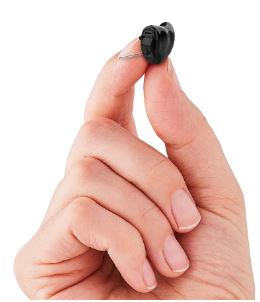 Overview: Starkey Genesis AI offers the smallest models that are almost entirely invisible and stands out as a top choice in the realm of custom-molded products. The larger sizes of custom aids (ITE/ITC) feature Bluetooth streaming and rechargeable batteries, catering to different degrees of hearing loss. While the slightly larger CIC Genesis AI model includes Bluetooth streaming (being the smallest Bluetooth device in its category), however, the smallest IIC and CIC versions lack Bluetooth and rechargeability, potentially incurring higher costs over time.
Overview: Starkey Genesis AI offers the smallest models that are almost entirely invisible and stands out as a top choice in the realm of custom-molded products. The larger sizes of custom aids (ITE/ITC) feature Bluetooth streaming and rechargeable batteries, catering to different degrees of hearing loss. While the slightly larger CIC Genesis AI model includes Bluetooth streaming (being the smallest Bluetooth device in its category), however, the smallest IIC and CIC versions lack Bluetooth and rechargeability, potentially incurring higher costs over time.
The Genesis AI hearing aids currently have a national average price of between $2000-$4000/ear, depending upon the technology level and other factors.
Pros:
- Smallest models almost entirely invisible.
- Leader in comfortable custom-molded products.
- Larger sizes feature Bluetooth streaming and rechargeable batteries.
- Suitable for a variety of hearing loss levels.
- CIC has Bluetooth streaming capability
- Starkey is known for intelligent features like fitness tracking, a virtual assistant, and the smallest Bluetooth hearing aid (one size bigger than the smallest range of their hearing aids) on the market.
Cons:
- Premium technology pricing
- Custom molds require additional lead time.
- Smallest version (IIC and smaller CIC) lacks Bluetooth and rechargeability.
- Potential for higher costs.
Sony CRE-C10: Affordable Excellence
Style: CIC
 Overview: Sony teamed up with WS Audiology (a well-established hearing care manufacturer) to co-create its hearing aid line. Sony’s CRE-C10 devices are nearly invisible and offer prescription-grade sound quality controlled through a smartphone. CRE-C10 does not offer Bluetooth streaming or rechargeable batteries. CRE-C10 uses a size 10 disposable battery that offers over 70 hours of continuous wear. Size 10 batteries are widely available and commonly used in small devices. Sony’s hearing aids were released in mid-October, so there are few reviews of the product, but it’s safe to say this will be a leading consideration for those who want an in-the-ear style device that is prescription-grade and also discreet.
Overview: Sony teamed up with WS Audiology (a well-established hearing care manufacturer) to co-create its hearing aid line. Sony’s CRE-C10 devices are nearly invisible and offer prescription-grade sound quality controlled through a smartphone. CRE-C10 does not offer Bluetooth streaming or rechargeable batteries. CRE-C10 uses a size 10 disposable battery that offers over 70 hours of continuous wear. Size 10 batteries are widely available and commonly used in small devices. Sony’s hearing aids were released in mid-October, so there are few reviews of the product, but it’s safe to say this will be a leading consideration for those who want an in-the-ear style device that is prescription-grade and also discreet.
Priced at $999/pair, the Sony CRE-C10 offers self-fit functionality using an app and provides high-quality sound at an affordable price. Its nearly invisible design and long battery life make it a compelling option for mild to moderate cases. However, it’s not rechargeable and lacks Bluetooth streaming capability.
Pros:
- Discreet-nearly invisible design.
- High-quality sound at an affordable price.
- Self-fit at home using the Sony Hearing Control app.
- App-based controls for personalized settings.
- Automatic sound adjustments for a comfortable listening experience.
Cons:
- Not rechargeable like similar size Eargo 7.
- No Bluetooth streaming capability.
- App functionality is limited
- Limited hearing loss range for mild to moderate cases.
Eargo 7: A Discreet Marvel
Style: CIC
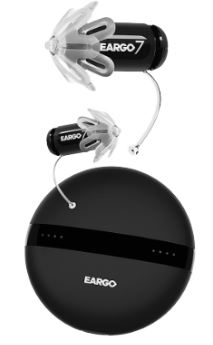 Overview: Currently priced at $2,950 for a set, Eargo 7 is a self-programmed, rechargeable hearing aid designed with a small device that sits entirely inside the ear. While they are set at a premium price compared to other OTC devices, the Eargo 7 is considered to be more affordable than many custom, prescription hearing aids. The company boasts a discreet and comfortable design with Eargo’s unique and patented “petal tip.” However, it’s only suitable for mild to moderate hearing loss and lacks Bluetooth capability due to its size.
Overview: Currently priced at $2,950 for a set, Eargo 7 is a self-programmed, rechargeable hearing aid designed with a small device that sits entirely inside the ear. While they are set at a premium price compared to other OTC devices, the Eargo 7 is considered to be more affordable than many custom, prescription hearing aids. The company boasts a discreet and comfortable design with Eargo’s unique and patented “petal tip.” However, it’s only suitable for mild to moderate hearing loss and lacks Bluetooth capability due to its size.
Pros:
- Small sized device that sits entirely inside the ear of most ears.
- More affordable than majority of custom fit hearing aids.
- Self-fit using an app
- Discreet and comfortable design, the petal tip keeps the ear canal ‘open’ for improved sound quality especially in the low frequencies
- Rechargeable battery with approximately 16 hours of use per charge.
Cons:
- Appropriate for mild to moderate hearing loss.
- Requires some adjustments for fine-tuning.
- Not Bluetooth enabled due to its small
- Limited to a smaller hearing loss range.
Phonak Lyric: The “Contact Lens of the Ear”
Style: Wearable 24/7, Analog Technology
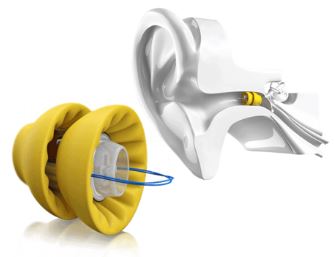 Overview: Available through a membership averaging around $4,000 per year, the Phonak Lyric is known as the most invisible hearing aid on the market. Designed for extended wear with no maintenance, charging, or battery replacements, it’s suitable for mild to moderately-severe hearing loss. However, it requires professional assistance for insertion and replacement, comes with an annual subscription cost, and lacks Bluetooth technology due to its small size.
Overview: Available through a membership averaging around $4,000 per year, the Phonak Lyric is known as the most invisible hearing aid on the market. Designed for extended wear with no maintenance, charging, or battery replacements, it’s suitable for mild to moderately-severe hearing loss. However, it requires professional assistance for insertion and replacement, comes with an annual subscription cost, and lacks Bluetooth technology due to its small size.
Pros:
- The most invisible hearing aid on the market.
- Extended wear with no maintenance, charging, or battery replacements.
- Suitable for mild to moderately severe hearing loss.
- Natural sound quality with analog processing.
Cons:
- Professional assistance required for insertion and replacement.
- Annual subscription cost.
- Limited user-adjustable settings.
- No Bluetooth technology due to its small size.
Signia Silk IX Charge&Go: Marvel for Active Seniors
Style: Completely-in-Canal, Invisible-in-Canal
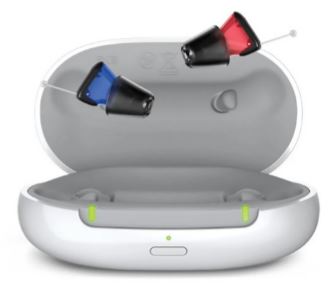 Overview: Signia’s latest Silk IX hearing aids introduce rechargeability as a key innovation while maintaining the same compact size and shape as its predecessors. They are the first prescription CIC devices to offer rechargeability. With a number of significant improvements over its predecessor, the Silk IX maintains the same physical dimensions, boasting similar battery performance in its rechargeable version. These ready-to-wear hearing aids come with semi-customizable designs and interchangeable domes to accommodate varying ear shapes (customized tips can also be ordered).
Overview: Signia’s latest Silk IX hearing aids introduce rechargeability as a key innovation while maintaining the same compact size and shape as its predecessors. They are the first prescription CIC devices to offer rechargeability. With a number of significant improvements over its predecessor, the Silk IX maintains the same physical dimensions, boasting similar battery performance in its rechargeable version. These ready-to-wear hearing aids come with semi-customizable designs and interchangeable domes to accommodate varying ear shapes (customized tips can also be ordered).
Targeted at individuals with mild to moderate hearing loss, the Silk IX includes different technology levels and features Signia’s Dynamic Soundscape Processing 3.0 for optimized hearing experiences. The aids also offer tinnitus management features and are the first rechargeable CIC CROS hearing aids globally.
Pros:
- Instant fit without traditional earmold procedures (especially useful for users who cannot travel to a health care provider (HCP) easily.
- Customizable fit with interchangeable silicone domes
- Ear-to-ear communication for enhanced sound directionality and CROS option
- Compact design for discretion
- Rechargeable
Cons:
- No audio streaming capability.
- Like other CIC devices, may not accommodate narrow or unusual shaped ear canals.
- Limited fitting range compared to other prescription aids.
- App functionality is limited compared to other Signia models
Oticon Own: Superior Sound Processing
Style: Customizable- IIC for most discreet option.
![]() Overview: The Oticon Own is fully customizable with AI technology for optimal sound processing. Offering Bluetooth streaming for audio and phone calls, it’s suitable for various hearing loss levels. The Oticon Own IIC features a custom-fitted, invisible-in-canal design with a comfortable fit and Deep Neural Network (DNN) technology. However, it requires professional fine-tuning and may come with a higher cost due to its custom-made design. It’s offered in 5 technology levels, with national average prices ranging from $1500-3500/ear.
Overview: The Oticon Own is fully customizable with AI technology for optimal sound processing. Offering Bluetooth streaming for audio and phone calls, it’s suitable for various hearing loss levels. The Oticon Own IIC features a custom-fitted, invisible-in-canal design with a comfortable fit and Deep Neural Network (DNN) technology. However, it requires professional fine-tuning and may come with a higher cost due to its custom-made design. It’s offered in 5 technology levels, with national average prices ranging from $1500-3500/ear.
Pros:
- Fully customizable with AI technology for optimal sound processing.
- Bluetooth streaming for audio and phone calls.
- Suitable for various hearing loss levels.
- Comfortable fit with Deep Neural Network (DNN) technology.
Cons:
- Limited user adjustability; requires professional fine-tuning.
- Potential higher cost due to custom-made design.
- Smaller sizes may limit fitting range
Conclusion:
In the world of invisible hearing aids, users can select a solution that matches their lifestyle, providing both discretion and advanced technology. The decision relies on personal preferences, hearing requirements, and budget considerations.
Whether choosing the discreet Eargo 7, the cost-effective Sony CRE-C10, the continuous wearable experience of Phonak Lyric, the compact Signia Silk IX for active seniors, the advanced sound processing of Oticon Own, or the customized Starkey Genesis AI, the future of hearing aids appears promising with these innovative and adaptable choices.
Resources:
About the Author
 Nausheen Dawood is an experienced Audiologist and Project Manager with a professional background including primary health care, corporate social investment, and business development. Proficient in the development of academic courses, training, and lecturing, with a focus on clinical student training and supervision. Adept in freelance copywriting, particularly in audiology and health-related topics. Holds a Masters degree in Audiology (Cum Laude), with a strong foundation in clinical research, project development, and strategic planning, complemented by technical training. Specializes in content development and training tailored to diverse audiences. Demonstrates a long-term commitment to research and development, including the implementation of randomized controlled trials, projects, and clinical examinations. Known for establishing robust networks and cultivating valuable stakeholder relationships.
Nausheen Dawood is an experienced Audiologist and Project Manager with a professional background including primary health care, corporate social investment, and business development. Proficient in the development of academic courses, training, and lecturing, with a focus on clinical student training and supervision. Adept in freelance copywriting, particularly in audiology and health-related topics. Holds a Masters degree in Audiology (Cum Laude), with a strong foundation in clinical research, project development, and strategic planning, complemented by technical training. Specializes in content development and training tailored to diverse audiences. Demonstrates a long-term commitment to research and development, including the implementation of randomized controlled trials, projects, and clinical examinations. Known for establishing robust networks and cultivating valuable stakeholder relationships.



